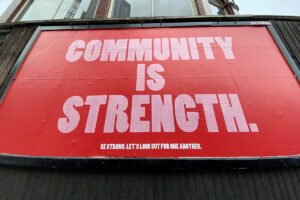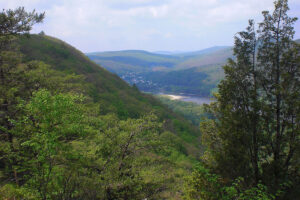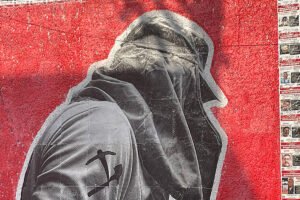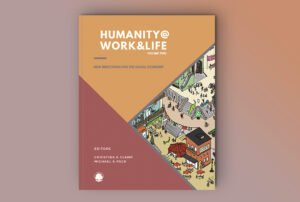
In January 2023, New York City’s Department of Transportation (DOT) went to the Williamsburg neighborhood in Brooklyn and removed the “Ave of Puerto Rico” street sign on Graham Avenue, where it had stood for over four decades. After intense community backlash, DOT reinstalled the sign three hours later and announced that it was a mistake. However, many community members said the removal was intentional and planned. Rumors that the sign would be removed had circulated as far back as 2013. Community members demanded answers from DOT Commissioner Ydanis Rodriguez and Mayor Eric Adams, but none were given.
For a sign to be taken down, work orders need to be moved through official channels for approval. Many community members believed that removing the sign indicated that City officials felt the Puerto Rican community in Williamsburg was so decimated by gentrification that no one would notice. City leaders were wrong.
The Puerto Rican Community Responds
Now in at least its fourth stage of gentrification, Williamsburg has become a contentious space for who gets to stay, live there, and claim it.
The DOT’s misstep galvanized residents, and 18 months later, in mid-June 2024, their community efforts bore fruit. Now, on the corner of Boerum Street and Graham Avenue, there is a new sign—Pedro Albizu Campos Way—named after the Nationalist Party leader who headed an uprising for Puerto Rico’s independence in 1950.
“It all started when I actually took a picture of the DOT taking down the Graham Avenue-Avenue of Puerto Rico sign,” says Gyvis Santos, a resident for over 40 years who led the effort to get the new street sign. “After that I just started realizing that we have no historical figures on Graham Avenue, and for many years that’s been a conversation in the community and in the neighborhoods.”
“We Are Still Here”: A Community Resists Gentrification
Gentrification has wreaked havoc on poor communities and communities of color in US urban centers and across the world. New York City has been at the forefront of this trend since at least the early 2000s when, after 9/11, former Mayor Michael Bloomberg implemented policies that greatly intensified the gentrification process his predecessors Edward Koch and Rudy Giuliani had laid out, geared toward commodifying housing.
Williamsburg and its neighbor, Greenpoint, were among the first neighborhoods in Brooklyn to experience exorbitant rent increases, which caused rapid displacement. While Williamsburg is known today as a playground for hipsters, it has been home to a large Puerto Rican population for decades, although gentrification has reduced the number of Puerto Ricans in the neighborhood. In commemoration of the community’s immense influence and contributions, Graham Avenue was renamed the Avenue of Puerto Rico in 1982. Now in at least its fourth stage of gentrification, Williamsburg has become a contentious space for who gets to stay, live there, and claim it.
The uprisings brought a more expansive critical awareness of Puerto Rico’s colonial relationship with the United States.
“It’s like a flag saying we are still here,” says Alba Delia Hernández, an educator, poet, and advocate for the new Pedro Albizu Campos sign. “We’re symbols of that. Even with gentrification. We’re holding on strong,”
Many might not know who Pedro Albizu Campos is and what he represents. “I teach to be able to educate our community about this history that we have not been taught. I’m pretty passionate about that because I didn’t hear about [people like Campos] at least until after I graduated college,” says Hernández.
Recalling Puerto Rico’s Anticolonial Struggle
A Harvard Law School valedictorian graduate and polyglot, Pedro Albizu Campos was offered opportunities to work at the highest levels of government in both the United States and Puerto Rico, but he decided to return to his island after graduating in 1921. Following his involvement in the Irish struggle for independence while at Harvard, he joined the Puerto Rican Nationalist Party. He became party vice president and then president in 1930, working diligently for Puerto Rico’s independence until he was arrested in 1950.
Sign up for our free newsletters
Subscribe to NPQ's newsletters to have our top stories delivered directly to your inbox.
By signing up, you agree to our privacy policy and terms of use, and to receive messages from NPQ and our partners.
Under the leadership of Albizu Campos, the Nationalist Party planned and executed concurrent armed revolts against US colonization in seven towns around the island and on the mainland, including an attack at Blair House in Washington, DC, where President Harry Truman was staying while the White House was undergoing renovations.
Although they did not win independence, the uprisings brought a more expansive critical awareness of Puerto Rico’s colonial relationship with the United States and greatly influenced other movements like the Young Lords Party. The uprisings also led the federal government to establish Puerto Rico’s current “Commonwealth” status—with increased, although still limited, autonomy—in 1952.
All of this history is represented by the new sign in Williamsburg. As Hernandez says, “The sign is a great starting point—whether it’s [supported by] a grant or sponsorship—to do some workshops, to create a mural, and have at least a paragraph about his name. I think these things are possible and now with a sign, it can be the start of a conversation.”
The Struggle Continues
Notable street signs can be important…to remember who we were and envision where we want to go.
There was an inauguration ceremony for the sign in July after Santos and Hernández presented in front of the Community Board and received the City’s approval. Turnout was modest; maybe two dozen people showed up. Still, Santos says, “People were stopping in cars and taking pictures. You always want a bigger outcome, but whoever was there needed to be there.”
For some, the new sign might also raise the question, “Is it worthwhile to rename a street after a Puerto Rican leader in a neighborhood when so many Puerto Ricans have been displaced?”
Santos says it is. “The Puerto Rican people will never leave the neighborhood. That doesn’t mean that they live there, but they will never leave. They will never leave the neighborhood, because their roots are in the neighborhood.”
Hernández notes that while the neighborhood remains a special place for Puerto Ricans in New York City—including those who have moved elsewhere—the degree of neighborhood change can be disconcerting. “I was caught off guard.…I still think of Williamsburg, and I still think of our community, and so when I didn’t see many people, I crossed off some things that I was going to read geared more towards a Puerto Rican audience and I just said factual stuff,” explains Hernández.
This kind of disconnect is one reason why notable street signs can be important. The signs can serve as a callback to return home—to remember who we were and envision where we want to go. Pedro Albizu Campos is a powerful Puerto Rican figure to send that message.
“The sign symbolizes that we can push forward,” Santos reflects. “Because I’ve been in the community for many years, I try to inspire the kids and the youth to do more and have more and get more. They deserve more. I always advocate for education. Right on the street, very grassroots, I tell these kids, build something, you deserve it.”











